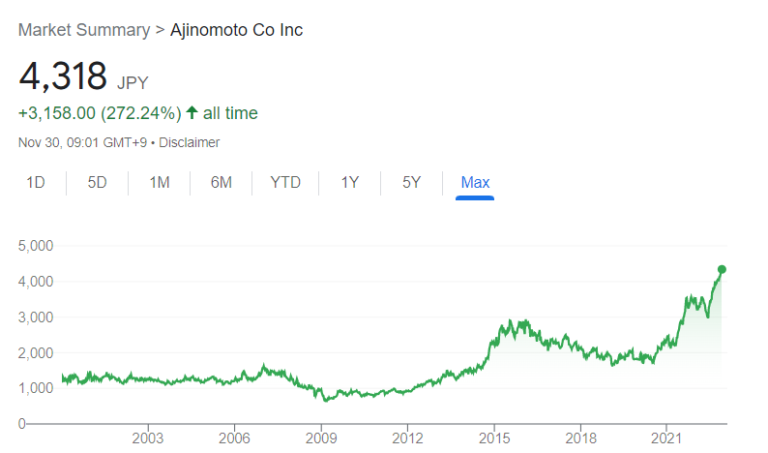A tweet from Mike Bird, Asia business and finance editor at The Economist, alerted me to the bizarre but instructive corporate evolution and recent success of Ajinomoto.
Since 1909, the company has produced its most famous product, monosodium glutamate (MSG), the sodium salt of an amino acid. As the first and leading manufacturer of MSG, Ajinomoto introduced the basic human taste of umami to the world with its seasoning.
But that’s not why Ajinomoto is a darling of the Tokyo Stock Exchange, rising 21% this year to an all-time high during a time when the Nikkei Stock Average has dropped 3%. The reason, as Bird noted in his tweet, is that the company “has redirected its work in amino acids to become a leading manufacturer of insulation for semiconductors.”
A NikkeiAsia article punnily noted, investors have “expressed a huge appetite for the company’s semiconductor material business.” In fact, the 20% of Ajinomoto’s non-food and seasoning business is now driving its growth, accounting for more than 40% of its expected profits for fiscal year 2023.
Ajinomoto’s strange journey from seasonings to semiconductors offers an important lesson about continuing to explore, not just for corporate survival but for our personal growth and success. No matter if the thing we are doing is working, whether it’s a job or a product or a project or a strategy, we should always be doing some exploring of other options. Even if the thing you are doing is going great, amazingly even.
When we direct our time, attention, money, and effort to something, that is time, attention, money, and effort we can’t can’t invest in other things, things that might be really good for us. In fact, once we start something, we often stop exploring other options altogether. And that’s a shame because the other options we might discover could turn out to be better than what we are currently doing. At minimum they offer back-up plans in case the thing you are doing disappears or becomes obsolete, which happens a lot in world rife with uncertainty.
And that is why Ajinomoto offers such a great lesson in decision-making. Because the thing they were doing, selling and developing seasonings, was going great.
Ajinomoto got in on the ground floor of the food business and expanded from that base over the last 113 (!) years. They still make umami seasonings and have a 94% market share in Japan, as well as flavor seasonings catering to local tastes throughout the world. In fiscal 2021, nearly 80% of their global sales were of seasonings and foods.
So how do you make the jump from a savory flavoring to semiconductors? With a willingness to explore even when you are the most successful business in your vertical.
Starting in the 1970s, Ajinomoto began researching applications of its knowledge of amino acids to epoxy resins and their composites. At the same time as it was developing successful (as well as unsuccessful) food and pharmaceutical products, it became a minor player in the expanding business of providing insulation for semiconductors. (Semiconductors, of course, are at the heart of practically all electronic devices.)
In the late 1990s, a small research team at the company developed a film-type insulator using amino acid technology. The revolutionary new material, Ajinomoto Build-up Film (ABF), arrived at just the right time. Then-current insulation technology wasn’t keeping up with the industry’s advancing needs. In addition, the semiconductor industry itself was in upheaval. In 1999, a leading semiconductor company gave the company’s researchers an introduction to the largest CPU maker. ABF has been the industry standard ever since.
The result of that willingness to explore now accounts for 40% of their expected profits this year.
The lifespan of a successful – well, once-successful – company is short and it’s getting shorter. According to a McKinsey & Co. survey, the average tenure of an S&P 500 company in the late 1970s was 35 years. It’s now closer to 20 years, and is projected to be just 12 years by 2027.
Ajinomoto seems to have avoided the traps that topple most successful companies: The safety of continuing to do what worked in the past, status quo bias, having and sticking with a defined corporate identity, and a failure to innovate and explore when you already have a winning strategy.
Of course, these are not just traps that businesses fall into. Each of us is subject to these same biases that keep us clinging to the status quo.

